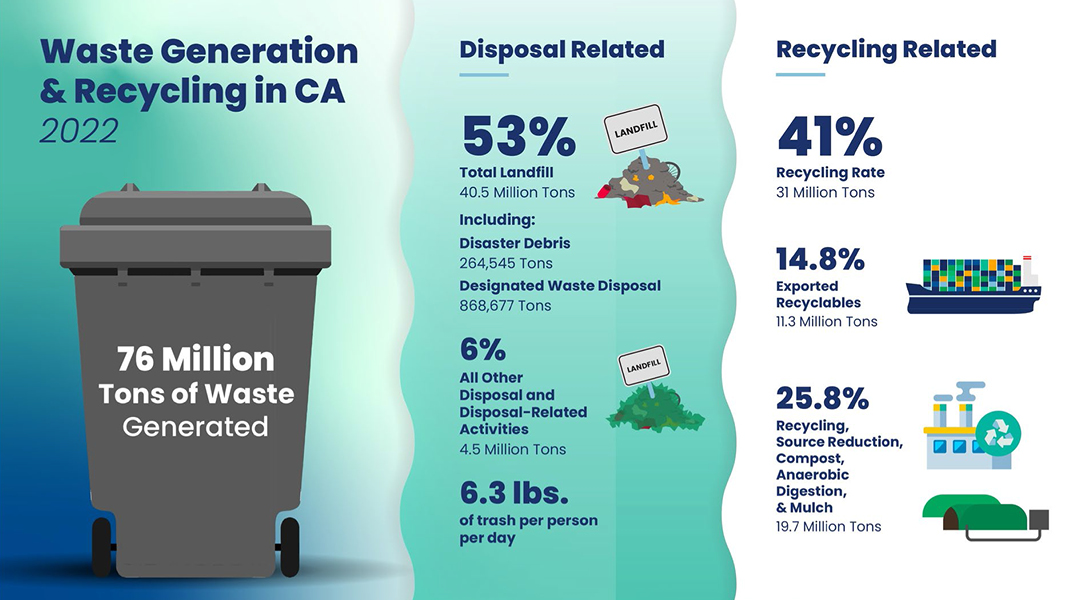
Waste generation. (Photo: era.gov)
Ringside: The Potential of Waste-to-Energy in California
Simply harvesting methane from existing landfills, as is already done throughout the state, may remain the most economical solution
By Edward Ring, April 17, 2024 2:45 am
When searching for new sources of renewable energy in California, harvesting the waste streams from our cities, farms, and forests is a logical option. But how much waste do these sources produce each year, and how much energy would they provide?
Answering this question at a summary level, while retaining some shred of credible and useful information is not easy, because the details can derail the feasibility of many waste-to-energy concepts. How much energy is expended getting the waste from its source to a conversion plant. How close are these plants to our garbage cans, an orchard that has been removed to be replaced with new trees, or thinnings from timber harvesting and forest management? Can a power plant be situated next to a landfill? Can power plants be disbursed in numbers sufficient to be in an efficient proximity to forest and agricultural land, without then being too small to be economical?
These are just some of the fundamental questions that complicate any assessment of waste-to-energy potential in California. Another complicating factor is just how much feedstock is available per year. From reviewing three credible sources – here, here, and here – some low to mid-range estimates of California’s capacity to produce waste-to-energy feedstock, expressed in bone dry tons: agricultural waste, are as follows: forest materials, 10 million tons per year; agricultural waste, 10 million tons per year; municipal solid waste, 20 million tons per year.
Expert estimates for these figures vary widely, especially in the case of forest waste. Based on an analysis of a 2010 USDA report, for example, just proper forest thinning to restore California’s forests to their healthy historical and much lower tree densities could yield an estimated 100 million tons of forest waste. That would be a one-time boost, but it could, for example, yield an additional 5 million tons of fuel for 20 years.
As for how much energy is in these waste streams, this in large part depends on what type of energy is to be extracted, and whether it will be further converted after that. One of the many companies commercializing advanced waste-to-energy systems is the California company Sierra Energy. They describe their waste gasification technology as a process that “uses steam and oxygen to break down waste at the molecular level. Organic materials turn into energy-dense syngas. Inorganics melt into non-leaching stone and metals. Waste turns into particulate and tar-free syngas suitable for conversion into high-value end products. There are no waste by-products created.”
Some of the end products that Sierra Energy’s system can convert waste into include electricity, hydrogen, methanol, and ammonia. In the case of electricity, of course, some intermediate step is necessary. The heat of the gasification can be used to drive a steam turbine, or the methanol can be used to drive a gas turbine, in both cases generating electricity. How much electricity?
Here again, estimates vary, but again based on expert assessments coming from here, here, and here, a consensus emerges that, using very rough numbers, 0.5 gigawatt-hours of electricity can be generated per dry ton of municipal solid waste, and 1.0 gigawatt-hours can be generated per dry ton both from forest materials or from agricultural waste. From here, the math is easy. Ten million tons of forest materials at 1.0 gigawatt-hours per ton will provide 10,000 gigawatt-hours of electricity. Ditto for agricultural waste. And to keep things neat, municipal solid waste at twice the volume and half the energy density – 20 million tons at 0.5 gigawatt-hours per ton – will also provide 10,000 gigawatt-hours of electricity.
This is an over-simplified analysis, but because these numbers are in the ballpark, it puts the potential of waste-to-energy conversion in California into a useful perspective. If fully realized, and applied 100 percent to electricity generation, California’s annual waste stream could contribute about 30,000 gigawatt-hours to the state’s grid, which is about 10 percent of the total energy currently being consumed by Californians each year.
Without diving into infinite nuances, it is important to note that in many cases there will be much better uses for California’s waste stream than conversion to electricity. As new conversion technologies are commercialized, turning waste into ammonia, for example, may be a superior value proposition. And in other cases, simply harvesting methane from existing landfills, as is already done throughout the state, may remain the most economical solution.
- Ringside: EVs and California’s Future Demand for Electricity - December 4, 2025
- Ringside: Politically Viable Water Supply Projects - November 27, 2025
- Ringside: Shifting Costs Does Not Solve California’s Electricity Shortages - November 20, 2025





Regarding forest waste. It is extremely energy intensive to move waste out of the forest to a processing plant. Not only that it is extremely expensive. The expense would far exceed the value of the logs produced which means the whole process would be economically Negative. Normally the logging waste is piled and burned or masticated in place. The technologies exist or can be developed but the economics cannot be altered. A power plant next door to a lumber mill is the only viable option.
The numbers I have seen for removing bug trees and transporting them to a chipping plant are around a thousand dollars per tree. I doubt you could get $10 worth of energy out of a tree and you would use at least $100 of energy to move it out of the forest, to a truck and then to the chipping plant.
The whole process should be called Blondie economics. Spend $100 to produce $10.